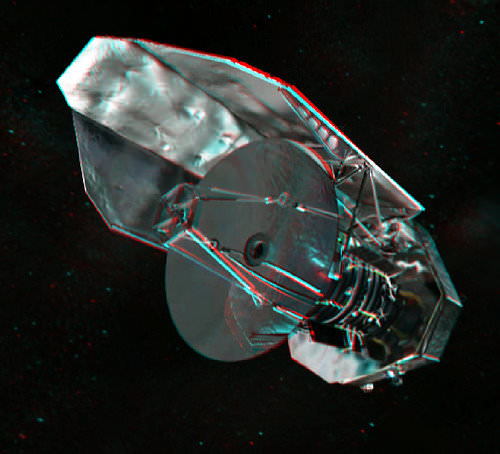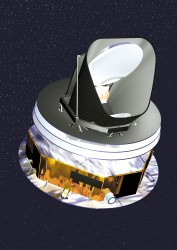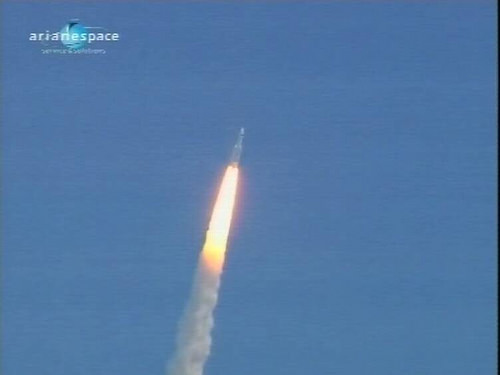[/caption]
The Herschel and Planck spacecraft successfully launched together Thursday from Europe’s Spaceport in Kourou, French Guiana. The Ariane V rocket performed flawlessly, with the rocket’s trajectory matching exactly the predicted flight path. The two spacecraft separated individually and in different directions from the launch vehicle, about four minutes apart, after spinning to orient themselves correctly for their high elliptical orbits. Just 40 minutes after lift-off, Herschel and Planck sent their first radio signals to Earth, confirming that they both are operating in good shape. In a few months, they will arrive at the L-2 (Lagrange) point in space, 1.5 million kilometers (930,000 miles) from Earth, beyond the Moon’s orbit. By early next year, they’ll begin operations to open new windows on the Universe. Herschel will be studying star formation while Planck will be looking back at the Big Bang.
Herschel will be looking at specific points in space while Planck will look at the whole sky.

This 3-D image of Herschel was created by Nathanial Burton-Bradford. Check out other images at his Flickr page.
Named after the 18th century astronomer who discovered infrared light, the Herschel spacecraft is 7 meters in length and 4 meters wide. The telescope mirror is 3.5 meters wide, 4 times bigger than previous space telescope, and will collect long-wavelength radiation from some of the coldest and most distant objects in the Universe. The mirror is also a technological wonder: it uses 12 silicon carbide petals fused together into a single piece. Herschel will be the only space observatory to cover a spectral range from the far infrared to sub-millimeter.
To detect cold, dark objects, Herschel has to be even colder. 2,400 liters of liquid helium cools the spacecraft to -273 Celsius. Like a thermal camera can see a person’s body heat, Herschel will look beyond dust and gas to see inside star forming regions, study comets and look into the distant universe where galaxies collide and give birth to stars. Scientists are planning for at least three years of operation from Herschel.

Planck will be sweeping the whole sky continuously to map out a picture of the Universe as it was 13.7 billion years ago. The spacecraft is four by four meters, with a 1.5 meter primary mirror that is surrounded with a baffle to limit any stray light from nearby objects, the Sun, Earth and Moon. Planck’s detectors have to be cold as well, and will be chilled to between 273 C to just 1/10th of degree above Absolute Zero.
Routine observations with Planck are expected to last for at least 15 months. The mission could be extended depending on the status of helium 3 isotope that is being used to chill the spacecraft.
Planck will test key questions in cosmology, investigating the cosmic microwave background, to ascertain the primordial constituents of the universe, and look for existence of gravitational waves. Planck will journey back in time, while giving us a better understanding of the future.


“By early next year, they will arrive at the L-2 (Lagrange) point in space beyond the Moon’s orbit”
Correction: Two weeks from launch, Herschel will be more than 1 million km away from Earth and will begin commissioning. The observatory will reach its operational orbit about a hundred days after launch.
That’s from ESA’s factsheet.
Thanks aerandir, I watched the webcast and I distinctly heard them say “3 months” until L2 orbits.
I watched the launch during a lecture at university 😉
But I asked the lecturer before, and since it was only a minor lecture (although it’s about VERY interesting topics, like the inner structure of stars) with only 4 students attending, I was allowed to keep the stream running silently.
I am very happy that Ariane did such a perfect job. Unimaginable what a loss that would’ve been…..
Well, remember the launch has been delayed several times…I bet at one time it was scheduled for a late 2008 launch they would reach L-2 early next year.
Great to see them safely on their way!
Way to go, Dr. Flimmer. That’s some dedication! Hopefully we’ll soon have some data to chew on from these two ‘scopes 🙂
Phew. That was a brave call, to launch two important observatories at once. Congratulations to all involved.
Thank God that went well. It would have been a disaster beyond imagining if the launch failed…
I cannot wait for the scientific pay-dirt from these observatories. It should give the theorists many headaches and sleepless nights, and put to pasture many theories that don’t make the cut. Sounds like progress to me!
Time for all of us involved with teaching in one form or another to revisit the whole topic of L points. They are relevant to a range of space science issues.
Brian.
Great article; a very confident ESA to launch these two together.
Possible correction: “Planck will be sweeping the whole sky continuously to map out a picture of the Universe as it was 13.7 million years ago.” should read 13.7 Billion?